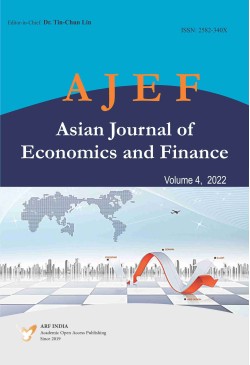
Asian Journal of Economics and Finance
Frequency :Quarterly
ISSN :2582-340X
Peer Reviewed Journal
This study investigates the relationship between international trade and economic growth in China from 1980 to 2018. Results from the cointegration test indicate that exports, imports, and FDI have positive relationships with economic growth, but oil price affects it negatively. Exports have the biggest effect on economic growth. Hence, it is important to improve the quantity and quality of exports, as well as motivate the local and foreign investment in the country. Besides, the Granger causality test results show bidirectional causality relationships between exports, imports, oil price, FDI and GDP in the short and long run.
Keywords: China, international trade, economic growth, foreign investment, VAR
JEL Code Classifications: O11, E20
The purpose of this paper is to evaluate a few nongovernmental organizations (NGOs) helping the sex workers to become selfreliant in West Bengal, India. A stratified random sampling method was adapted to survey 400 sexworkers using a structured survey questionnaire. A Program Effectiveness Index (PEI) is developed to measure the level of disparity in the effectiveness of these NGOs operating in the urban vs. suburban areas of West Bengal, India. The effectiveness is manifested through the level of selfreliance achieved by the participating sexworkers. The selfreliance gap between the participating sex workers in the two regions is measured by the weighted average status gap (WASG) using several social, economic, psychological, political, and legal status indicators. The estimated Program Effectiveness Index value of 66.16 indicates disparity in effectiveness of the intervention programs between the two regions. A negative WASG value implies the suburban sexworkers to be more selfreliant than the urban sexworkers, mainly in their ‘economic’ and ‘health’ status. A simple sensitivity analysis suggests how policy makers can benchmark a certain rate of progress per year to achieve zero disparity within a set number of years. The index developed in this paper can provide a guideline for the policy makers as to where, on a scale of 0 to 100, the disparity is desirable to achieve the targeted balance in regional development. This kind of findings could be relevant for policy makers in allocating resources to programs in different regions to achieve desired outcomes. No attempt has been found in any prior studies to compare the effectiveness of the intervention programs operating in different regions in creating selfreliance among the sexworkers. In that sense, the current research is a novel approach trying to quantitatively measure the regional disparity in effectiveness of the intervention programs targeted specifically for sexworkers. The index developed in this paper measures the extent of disparity in the effectiveness of the programs through the difference in the level of selfreliance of the sexworkers while geographically separated into the urban and suburban areas.
Keywords: Empowerment; selfreliance; community development; sexworkers; NGOs; intervention programs.
JEL classifications: I38, J16, J71, J78
Repeated “crises” in the banking institutions have shown information asymmetry in the pricing of risker assets and even institutions that should have mature risk monitoring systems fail to detect and price accordingly to prevent systemic risk. The paper explores the reason behind this. During noncrisis period, peer market discipline was relied on since it is found empirically that there exists monitoring incentive of wholesale debt holder. However, the market discipline could be ineffective due to moral hazard and less lender accountability of shortterm wholesale lender. Specifically, this paper presents a stylized model, in which borrowing banks tend to choose a higher share of “bad” assets to maximize their net expected return. Moreover, the model also shows that the effectiveness of monitoring will diminish as the maturity shortens.
Keywords: Market Discipline, Moral Hazard, Lender Accountability
JEL: G01, G21, G38
Nepal made significant progress in removing monarchy and terrors of Maoists in the last decade. It however lacks a stable solution for speedier economic growth and development as the major political parties are still struggling to institutionalize the new political framework set up by the new constitution of Nepal that was promulgated by the Constitution Assembly of Nepal (CANII) for the federal democratic republic of Nepal on 20 September 2015. Nepalese economy crippled by the terrible earthquake of April 2015. NC led government managed to conduct free and fair elections of central, provincial and local governments by the end of 2017 in which the NCP, a new alliance of communist CPNUML and CPNMaoist parties was able to secure the absolute majority based on radical manifesto promises relegating the NC to a weak opposition. The NCP government has however failed totally to implement its promises in practice bringing inclusive programmes suitable to multi ethnic, multi climatic and multicultural and multi linguistic economy and society. Corruption has spread further from the top to the bottom. Quality of institutions, leadership and the governance has further deteriorated. Faster economic growth and development is not possible unless the new system sticks to a dynamic model for a decentralized economy updating beliefs that can improve the well being of people and transform Nepal into a modern, vibrant, and market oriented dynamic economy. Nepal should avoid economically and topographically unrealistic trans Himalayan trade efforts with China and should improve mutual and natural understanding and cooperation with India to sustain growth in the long run.
Keywords: constitution, institution, Nepal, economic growth and development.
JEL classification: 05, P5
The paper analyses debt inflation dynamics in India, covering the time period 1980-81 to 2018-19. The empirical analysis covers both indirect and direct effects of growth in debt on inflation. The results indicate the presence of weak financial crowding out effect in the post reform phase. The monetisation channel remains important even as it operates through the liquidity module in the GSec market post 2006. The Granger causality test shows that the WPI inflation is granger caused, among other factors, by the past values of central government debt. The VAR estimation establishes that debt growth has a positive effect on inflation rate in India.
Keywords: Debt, Liabilities, Interest Rate, Inflation
JEL Classification: H6, E4, E31